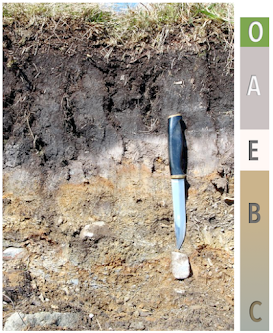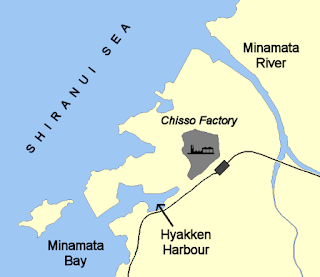SOIL PROFILE AND CLIMATE
The soil profile is an important tool in nutrient management. Examining a soil profile can provide valuable insight into soil fertility. The soil profile changes as the soil weathers and/or organic matter decomposes. A soil profile is a vertical section of soil, as shown in the figure below.
Soils are formed due interaction of five major factors: time, climate, parent material, topography and relief, and organisms. The relative influence of each element varies from place to place. However, the combination of all five factors determines the soil development in any given area. Scientists know that climate is the most important factor determining soil type because, given enough time, different rock types in a given climate will produce similar soil, as shown in the image below. Even the same rock type in different climates will have different soil types. This is true because most rocks on Earth are made of the same eight elements, and when the rock breaks down to become soil, those elements dominate.

Source: National Weather Service (NWS)
Soil is affected by wind, rainfall, temperature, light and humidity. These important climatic factors affect the soil profile and change the soil structure. Below are two examples of climatic factors' unfavourable effects on the soil profile: Soil erosion and low organic matter content.

Source: National Weather Service (NWS)
Soil is affected by wind, rainfall, temperature, light and humidity. These important climatic factors affect the soil profile and change the soil structure. Below are two examples of climatic factors' unfavourable effects on the soil profile: Soil erosion and low organic matter content.
- Erosion: is a movement of surface soil caused by various factors, mainly hydric and wind agents, which results in the reduction of the depth of the upper horizon (O horizon), changes in the characteristics of the soil and the alteration of its capacity to support the development of the plant.
The wind is an effective agent of erosion of fine and loose materials, capable of starting, lifting and transporting particles. Its ability to erode harder compact rocks depends mainly on the speed of the wind and the greater or lesser compaction of those rocks. Wind action causes wind erosion, a type of rock wear or soil removal.
Soil erosion is also caused by the infiltration of rainwater running off the surface of a field. Hydric erosion and surface water runoff are often considered unavoidable phenomena associated with agriculture on sloped land. However, soil loss and runoff are not inevitable natural phenomena. The appearance of damage caused by erosion in cultivated areas is a symptom of inadequate cultivation methods.
- Low organic matter content: Together with soil moisture, temperature influences the organic matter content of the soil (horizons O and A shown in the image below) and has a very important role in the balance between plant growth (the contribution of biomass) and microbial decomposition. If temperatures are high and water is abundant in the profile, the weathering and washing process will be maximum. That is why the poorly developed soils of cold climates contrast with the deep, heavily weathered profiles of tropical (warm and humid) areas.
Ground temperature is directly associated with the atmosphere's temperature because the ground is an insulator of heat flow between the solid Earth and the atmosphere. For example, on a sunny day, the ground absorbs energy from the sun, and its temperature rises. Temperature acts by doubling the rate of chemical reactions for every increase of 10ºC; therefore, soils develop faster in warm, moist climates and slowest in cold or arid ones.
References:
CHRISTENSEN, L.A., MCELYEA, D.E. 1988. Toward a general method of estimating productivity–soil depth response relationships. J. Soil and Water Cons. 43:199–202
Lal, R., 1982: Management of clay soils for erosion control. Tropical Agric., 59 (2), 133 - 138.
1. GENERALIDADES (fao.org)
Soil Management (hawaii.edu)
Soil Profiles (tocal.nsw.edu.au)
Factors of Soil Formation, Plymouth County (nesoil.com)
Soil Formation ( Read ) | Earth Science | CK-12 Foundation (ck12.org)
Microsoft Word - TESIS (ismm.edu.cu)
erosion del suelo por agua de lluvia - Engormix
Microsoft Word - 04 01 soil_welcome OK.doc ccv.doc (globe.gov)
www.srh.noaa.gov



